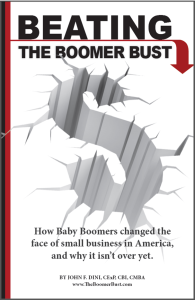As Baby Boomers business owners approach retirement (the youngest of them turned 50 this year) they face a unique challenge. The market for small businesses is increasingly a buyer’s smorgasbord A shrinking middle-aged population, corporate competition for talent and less interest in the long hours associated with many traditional small businesses combine to make selling many Boomer enterprises a more difficult proposition.
The best-of-class companies on both the smaller and larger end of the spectrum will still stand out as appealing propositions to buyers. On the main street side (companies selling for less than $3 million or so) there are still plenty of aspiring entrepreneurs who seek a lucrative opportunity.
The mid-market (companies with over $1 million of pre-tax income) has more money chasing fewer target prospects. Current estimates calculate over $1.6 trillion (about the GDP of Japan) allocated by Private Equity Groups and corporate M&A departments for purchasing those businesses.
 What about the companies in the middle? As in the Star Trek “Neutral Zone,” the place where neither the Federation nor the Romulans travel, these businesses have a special challenge when their owners seek to transition, and especially when they want to exit with the value of what they’ve built.
What about the companies in the middle? As in the Star Trek “Neutral Zone,” the place where neither the Federation nor the Romulans travel, these businesses have a special challenge when their owners seek to transition, and especially when they want to exit with the value of what they’ve built.
A generic history of these Neutral Zone companies applies to thousands of them. A Boomer entrepreneur bootstrapped a business thirty years ago. Badly undercapitalized, he or she struggled for years to make a decent living. As time passed, a four decade long expanding economy, driven by the influx of workers and consumers from the same generation, helped to grow the business until it provided a comfortable living.
Now in their 50s or 60s, those owners have achieved their life goals. Their labors have resulted in an enterprise that employs between 15 and 50 people, and puts between 300,000 and a million dollars to the bottom line above and beyond their own salaries. Compared to 95% of Americans, they are “rich.”
But they are too big to sell easily in the small business (main street) markets, and too small to attract mid-market buyers. They are in the Neutral Zone.
In main street sales (as I’ve explained here before) solid companies sell for an upper limit of around three times the pre-tax profit combined with the owner’s salary and benefits. As that pricing exceeds $3 million, and certainly above $4 million, it becomes difficult to find an individual entrepreneur who can leverage that purchase price.
In the mid-market, where the cost of a transaction limits targets to those with $1 million and more in EBITDA, many Neutral Zone owners would have to grow the business by 30% to 70% just to make the entry level numbers.
A Boomer entrepreneur who is in the “harvesting” phase of business ownership; enjoying the benefits that come from decades of dedication to the business, is often not interested in another big push. It may require more investment, more risk, and probably a lot more effort.
He or she built the company with a belief that it would fund a certain post-business lifestyle upon sale. Now they are finding out that a well run organization with solid and sustained profitability may not be enough.
I typically work with between 15 and 25 of these owners at any given time. For many, the solution can be to “hire a buyer.” Their companies are financially capable of recruiting top management talent. That talent should first be capable of taking the day-to-day management duties from the owner, but in addition, be entrepreneurial enough to eventually assume ownership in turn.
The secret to realizing the full value of a Neutral Zone company may not lie in bringing it up to another level (or, perish the thought, down to a lower level) of prospective buyers. Instead, consider using the organizational strength and profitability you’ve created to engineer an internal sale on your own terms, in your own time, and under your control.
Do you enjoy “Awake at 2 o’clock?” Please share it with other business owners.




